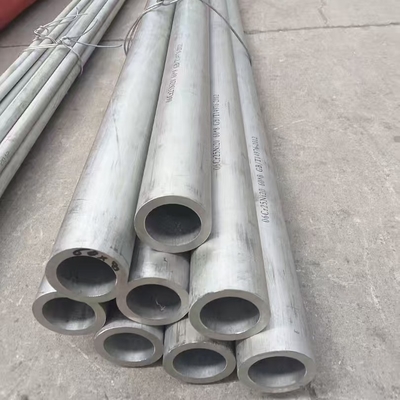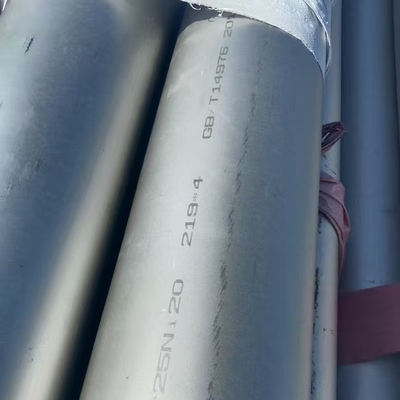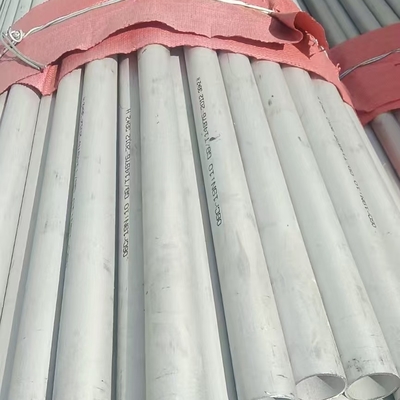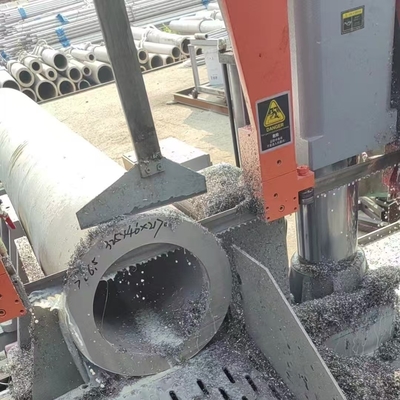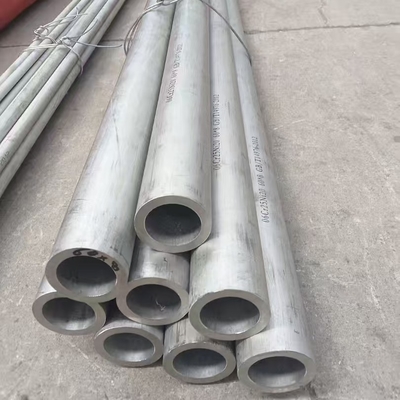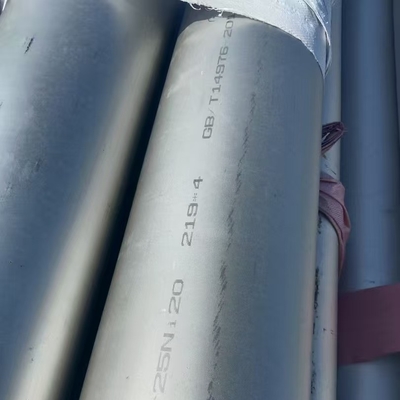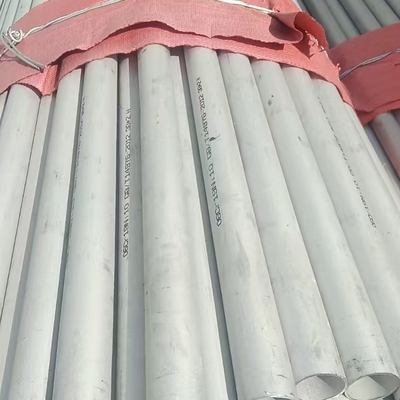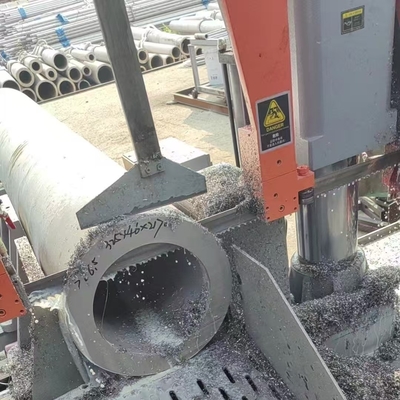-
 Raian IonescuΥλική ποιότητα πολύ υψηλή. πρέπει να συνεργαστούμε περισσότερο από 10 έτη. Ανταλλάσσουν τα είδη μερών υλικού χάλυβα. Όλο το υλικό ποιοτικό αγαθό. Αυτοί δασμός για όλη την υλική ποιότητα. Πλανίζουμε συνεχιζόμαστε συνεργαζόμαστε με τους στο μέλλον
Raian IonescuΥλική ποιότητα πολύ υψηλή. πρέπει να συνεργαστούμε περισσότερο από 10 έτη. Ανταλλάσσουν τα είδη μερών υλικού χάλυβα. Όλο το υλικό ποιοτικό αγαθό. Αυτοί δασμός για όλη την υλική ποιότητα. Πλανίζουμε συνεχιζόμαστε συνεργαζόμαστε με τους στο μέλλον
Σωλήνας από ανοξείδωτο χάλυβα 309S ανθεκτικός στη θερμότητα, σωλήνας SS σε μήκος 6m, φινίρισμα επιφάνειας με μαρινάρισμα & γυάλισμα
| Τόπος καταγωγής | Κίνα |
|---|---|
| Μάρκα | DELTA |
| Πιστοποίηση | ISO |
| Αριθμό μοντέλου | 309S |
| Ποσότητα παραγγελίας min | 1000 κιλά |
| Τιμή | 3.2 - 4.5 USD/Kg |
| Συσκευασία λεπτομέρειες | τυπική συσκευασία για εξαγωγή |
| Χρόνος παράδοσης | 5 - 12 ημέρες με βάση την ποσότητα |
| Όροι πληρωμής | L/C, T/T, Western Union |
| Δυνατότητα προσφοράς | 4 τόνοι την εβδομάδα |

Με ελάτε σε επαφή με δωρεάν δείγματα και δελτία.
Whatsapp:0086 18588475571
Wechat: 0086 18588475571
Skype: sales10@aixton.com
Εάν έχετε οποιαδήποτε ανησυχία, παρέχουμε τη 24ωρη σε απευθείας σύνδεση βοήθεια.
x| Προϊόντα | Σωλήνας από ανοξείδωτο χάλυβα | Βαθμός | 309S |
|---|---|---|---|
| Διάμετρος | DN10 - DN400 | Μήκος | 6m ή προσαρμοσμένη κοπή οποιουδήποτε μήκους ως αίτημα |
| Πρότυπο | Astm en | Υπηρεσία | Τομή |
| Θύρα φόρτωσης | Λιμάνι της Σαγκάης | Πάχος | 4.0 - 50.0mm |
| Επισημαίνω | Σωλήνας από ανοξείδωτο χάλυβα 309S ανθεκτικός στη θερμότητα,Σωλήνας από ανοξείδωτο χάλυβα μήκους 6m,Σωλήνας SS με φωτεινή επιφάνεια μαρινάρισματος |
||
Ανθεκτικός στη θερμότητα σωλήνας από ανοξείδωτο χάλυβα 309S σωλήνας SS σωλήνα μήκους 6 μέτρων
Προδιαγραφή προϊόντων
| Ονομασία των προϊόντων | 309S Χάλυβα από ανοξείδωτο χάλυβα |
Αξία: |
304 304L 304LN 304H 309S 310S 314 315 316L 316Ti 317L 321 329 347H 410 2205 2507 2550 S32760 904L 254SMO και ίσης ποιότητας στο GB JIS EN DIN Standard |
| Πρότυπα: | ΑΣTM A213M-94b ΑΣTM A249M-94a ΑΣTM A269-94a ΑΣTM A312M-94b,εκκ. |
| DIN 17456-85 DIN 17458-85 DIN 17459-92.ect | |
| Η Ελλάδα δεν μπορεί να θεωρηθεί ότι είναι υπεύθυνη για την εκτέλεση των καθηκόντων που της ανατίθενται. | |
| Ειδικότερα, η Ελβετία έχει επιβεβαιώσει ότι η Ελβετία είναι η χώρα με την υψηλότερη αναπτυξιακή οικονομία. | |
| Μέγεθος: | ND5 - DN400 |
| Διάρκεια: | 6m μήκος ή κοπή οποιουδήποτε μήκους κατόπιν αιτήματος |
| Εφαρμογές: | Μεταφορά υγρών και αερίων, κατασκευή, λέβητα, ανταλλακτής θερμότητας, υπερθερμαντήρα |
Ο σωλήνας από ανοξείδωτο χάλυβα 309S είναι ένα προϊόν austenitic ανοξείδωτου χάλυβα υψηλών επιδόσεων που έχει σχεδιαστεί ειδικά για εφαρμογές σε ακραίες θερμοκρασίες.Αυτό το ανθεκτικό στη θερμότητα κράμα παρουσιάζει εξαιρετικές επιδόσεις σε περιβάλλοντα όπου οι θερμοκρασίες κυμαίνονται από 850°C έως 1100°CΤο πρότυπο μήκος 6 μέτρων προσφέρει πρακτικότητα για βιομηχανική εγκατάσταση και χειρισμό.Ενώ η αψίλωση και η φωτεινή επιφάνεια όχι μόνο ενισχύουν την αισθητική του, αλλά βελτιώνουν επίσης την αντοχή στη διάβρωση, αφαιρώντας τις ακαθαρσίες και δημιουργώντας ένα παθητικό προστατευτικό στρώμα.. This combination of properties makes 309S stainless steel pipes particularly valuable in industries requiring materials that can maintain structural integrity under thermal stress and corrosive conditions5.
Η διαδικασία ακινητοποίησης περιλαμβάνει χημική επεξεργασία που αφαιρεί την κλίμακα και τις ακαθαρσίες από την επιφάνεια μετά από θερμική επεξεργασία,ενώ το φωτεινό φινίρισμα παρέχει μια ομαλή επιφάνεια που μειώνει την προσκόλληση των μολυσματικών ουσιών και διευκολύνει το καθαρισμόΟι επιφανειακές επεξεργασίες αυτές είναι ιδιαίτερα σημαντικές για εφαρμογές που απαιτούν αυστηρά πρότυπα υγιεινής ή όπου η ελαχιστοποίηση της τριβής και της αντίστασης στην ροή του υλικού είναι ζωτικής σημασίας.Οι σωλήνες κατασκευάζονται είτε με αδιάλειπτες είτε με συγκολλημένες διαδικασίες, με απρόσκοπτες εκδόσεις που προσφέρουν βελτιωμένες δυνατότητες περιορισμού πίεσης για εφαρμογές υψηλής πίεσης26.
2 Βασικές παραμέτρους
2.1 Χημική σύνθεση
Η χημική σύνθεση του σωλήνα από ανοξείδωτο χάλυβα 309S είναι προσεκτικά ισορροπημένη ώστε να παρέχει βέλτιστες επιδόσεις σε υψηλές θερμοκρασίες και αντοχή στη διάβρωση.Η ελεγχόμενη περιεκτικότητα σε άνθρακα είναι ιδιαίτερα σημαντική, καθώς ελαχιστοποιεί την κατάπτωση καρβιδίου κατά τη διάρκεια της συγκόλλησης και της έκθεσης σε υψηλές θερμοκρασίες, διατηρώντας έτσι την αντοχή στη διάβρωση σε σκληρά περιβάλλοντα1.
Πίνακας: Απαιτήσεις χημικής σύνθεσης σωλήνων από ανοξείδωτο χάλυβα 309S
| Στοιχείο | Περιεκτικότητα (%) | Λειτουργία |
|---|---|---|
| Άνθρακας (C) | ≤0.08 | Βελτιώνει τη συγκόλληση και μειώνει την κατάπτωση καρβιδίων |
| Μαγγάνιο (Mn) | ≤ 2.00 | Βελτιώνει την αντοχή και την εργασιακή ικανότητα |
| Σιλικόνη (Si) | ≤ 1.00 | Αύξηση της αντοχής στην κλίμακα και την οξείδωση |
| Φωσφόρος (P) | ≤0.045 | Στοιχείο ακαθαρσίας σε χαμηλά επίπεδα |
| Θείο (S) | ≤0.030 | Βελτιώνει τη μηχανική ικανότητα (λιγιά υψηλότερη από ό,τι στις τυποποιημένες ποιότητες) |
| Χρώμιο (Cr) | 22.0-24.0 | Παρέχει αντοχή στην οξείδωση σε υψηλές θερμοκρασίες και αντοχή στη διάβρωση |
| Νικέλιο (Ni) | 12.0-15.0 | Σταθεροποιεί την αυστενιτική δομή και παρέχει αντοχή στην θερμική ροή και την κυκλική θέρμανση |
2.2 Μηχανικές ιδιότητες
Οι μηχανικές ιδιότητες των σωλήνων από ανοξείδωτο χάλυβα 309S παραμένουν σταθερές σε ευρύ εύρος θερμοκρασιών,που τα καθιστούν κατάλληλα για εφαρμογές υψηλών θερμοκρασιών όπου πολλά άλλα υλικά θα έχαναν γρήγορα την αντοχή τουςΤο υλικό προσφέρει έναν εξαιρετικό συνδυασμό αντοχής και ευελιξίας, επιτρέποντάς του να αντέχει τόσο τις μηχανικές πιέσεις όσο και τον θερμικό κύκλο χωρίς βλάβη17.
Πίνακας: Μηχανικές ιδιότητες σωλήνων από ανοξείδωτο χάλυβα 309S
| Ιδιοκτησία | Αξία | Πρότυπο δοκιμής |
|---|---|---|
| Δυνατότητα τράβηξης | ≥ 515-520 MPa | ΑΣTM A554 |
| Δύναμη απόδοσης | ≥205-207 MPa | ΑΣTM A554 |
| Επέκταση | ≥ 35-40% | ΑΣTM A554 |
| Σκληρότητα (Brinell) | ≤187 HB | ΑΣTM A554 |
| Σφιχτότητα | 70,98 g/cm3 | - |
| Σημείο τήξης | 1400-1450°C | - |
3 Ιδιότητες και χαρακτηριστικά
3.1 Επιδόσεις σε υψηλές θερμοκρασίες
Οι σωλήνες από ανοξείδωτο χάλυβα 309S παρουσιάζουν εξαιρετική αντοχή στη θερμότητα που τους επιτρέπει να λειτουργούν για μεγάλο χρονικό διάστημα σε θερμοκρασίες έως 980 ° C (1796 ° F) με διαλείπουσα έκθεση σε 1000 ° C (1832 ° F).Αυτή η αξιοσημείωτη απόδοση οφείλεται στην υψηλή περιεκτικότητα τους σε χρώμιο (22-24%)., το οποίο σχηματίζει ένα σταθερό, αυτοθεραπευτικό στρώμα οξειδίου του χρωμίου στην επιφάνεια όταν εκτίθεται σε υψηλές θερμοκρασίες.Αυτό το προστατευτικό στρώμα αποτρέπει αποτελεσματικά την περαιτέρω οξείδωση και αποδόμηση του υποκείμενου υλικού. The nickel content (12-15%) contributes to maintaining the austenitic structure and provides resistance against thermal creep—a gradual deformation under mechanical stress at high temperatures that affects many materials15.
Οι σωλήνες παρουσιάζουν εξαιρετικές ιδιότητες κατά της αποσύνθεσης και αντοχή στην κυκλική οξείδωση, γεγονός που τους καθιστά κατάλληλους για εφαρμογές που περιλαμβάνουν επαναλαμβανόμενους κύκλους θέρμανσης και ψύξης.Σε αντίθεση με τα συνηθισμένα ανοξείδωτα χάλυβα, τα οποία μπορεί να σχηματίσουν εύθραυστες φάσεις ή να υποστούν σημαντική κλίμακα μετά από παρατεταμένη έκθεση σε υψηλές θερμοκρασίεςΤο 309S διατηρεί τη δομική του ακεραιότητα.08.0%) βοηθά ειδικά στην πρόληψη της ευαισθητοποίησης, του σχηματισμού καρβιδίων του χρωμίου στα όρια των κόκκων, το οποίο μπορεί να οδηγήσει σε διασωματική διάβρωση σε άλλους ανοξείδωτους χάλυβες9..
3.2 Αντίσταση στη διάβρωση
Η αντοχή στη διάβρωση των σωλήνων από ανοξείδωτο χάλυβα 309S επεκτείνεται πέρα από την οξείδωση σε υψηλές θερμοκρασίες για να περιλαμβάνει διάφορα χημικά περιβάλλοντα.Η υψηλή περιεκτικότητα σε χρώμιο και νικέλιο παρέχει ανώτερη αντοχή σε οξειδωτικά οξέα και σε πολλές οργανικές χημικές ουσίες σε σύγκριση με τα τυποποιημένα ανοξείδωτα χάλυβα 304 και 316.Αυτό καθιστά τους σωλήνες 309S κατάλληλους για εφαρμογές όπου υπάρχουν τόσο υψηλές θερμοκρασίες όσο και διαβρωτικά μέσα, όπως σε θερμαντήρες χημικής επεξεργασίας και φούρνους διυλιστηρίων59.
Επιπλέον, το 309S παρουσιάζει καλή αντοχή σε επιθέσεις θειοποίησης,που είναι ιδιαίτερα χρήσιμο στις εφαρμογές διύλισης πετρελαίου και επεξεργασίας άνθρακα όπου οι ενώσεις θείου είναι παρόντες σε υψηλές θερμοκρασίες. The material also resists carburization—the absorption of carbon into the metal surface in carbon-rich atmospheres at high temperatures—which can cause embrittlement and loss of mechanical properties in other steelsΑυτός ο συνδυασμός ιδιοτήτων επιτρέπει στους σωλήνες 309S να διατηρούν την ακεραιότητα των τοιχωμάτων τους ακόμη και όταν εκτίθενται σε επιθετικά περιβάλλοντα καθ' όλη τη διάρκεια ζωής τους1.
3.3 Μηχανικές και φυσικές ιδιότητες
Οι μηχανικές ιδιότητες των σωλήνων από ανοξείδωτο χάλυβα 309S σε θερμοκρασία δωματίου περιλαμβάνουν αντοχή σε τράβηξη ≥ 515-520 MPa και αντοχή απόδοσης ≥ 205-207 MPa, με επιμήκυνση άνω του 35-40%.Αυτές οι ιδιότητες παρέχουν εξαιρετική δομική ικανότητα, διατηρώντας ταυτόχρονα καλή διαμόρφωση και συγκολλητικότηταΗ υψηλή τιμή επιμήκυνσης υποδεικνύει την εύκαμπτη συμπεριφορά, η οποία είναι σημαντική για την αντοχή σε μηχανικά σοκ και θερμικές πιέσεις χωρίς εύθραυστη κατάρρευση79.
Καθώς η θερμοκρασία αυξάνεται, το 309S διατηρεί τις μηχανικές του ιδιότητες καλύτερα από τους περισσότερους τυπικούς ανοξείδωτους χάλυβες.Η αντοχή σε υψηλές θερμοκρασίες παραμένει επαρκής για τη δομική υποστήριξη σε εφαρμογές φούρνου, ενώ ο συντελεστής θερμικής διαστολής (περίπου 16,5 μm/m· °C μεταξύ 20-100 °C) είναι συμβατός με πολλά άλλα ανθεκτικά στη θερμότητα υλικά, μειώνοντας τα προβλήματα θερμικής πίεσης στις συναρμολογήσεις.Η θερμική αγωγιμότητα περίπου 14.2 W/m·K σε θερμοκρασία 100°C συμβάλλει στην ομοιόμορφη κατανομή της θερμότητας, ελαχιστοποιώντας τα τοπικά θερμά σημεία που θα μπορούσαν να οδηγήσουν σε πρόωρη βλάβη9.
4 Διαδικασία κατασκευής
4.1 Η ροή εργασίας παραγωγής
Η κατασκευή σωλήνων από ανοξείδωτο χάλυβα 309S ακολουθεί μια σχολαστική ροή παραγωγής που εξασφαλίζει σταθερή ποιότητα και χαρακτηριστικά απόδοσης.Η διαδικασία ξεκινά με στρογγυλά σφαιρίδια από χάλυβα που θερμαίνονται σε θερμοκρασία περίπου 1200 °C σε περιστρεφόμενο φούρνο.Αυτά τα θερμαινόμενα σκελετά τρυπούνται στη συνέχεια μέσα από το κέντρο χρησιμοποιώντας ένα μανδρέλι για να δημιουργήσουν ένα κούφιο κέλυφος.Τα τρυπημένα σφαιρίδια υποβάλλονται σε επιμήκυνση μέσω ενός πριονιστηρίου ή μιας διαδικασίας πριονιστηρίου για να επιτευχθεί η επιθυμητή διάμετρος και πάχος του τοίχουΟι μεταγενέστεροι κυλίνδροι μεγέθους εξασφαλίζουν ακριβή διαμετρική ακρίβεια πριν από την κοπή των σωλήνων σε πρότυπο μήκος 6 μέτρων210.
Για τους συγκολλημένους σωλήνες, η διαδικασία ξεκινά με ψυχρά τυλιγμένους κυλίνδρους οι οποίοι κόβονται στο απαιτούμενο πλάτος.Η συγκόλληση υψηλής συχνότητας ή η συγκόλληση TIG χρησιμοποιείται για τη δημιουργία μιας διαμήκης συγκόλλησης χωρίς την προσθήκη υλικού πλήρωσηςΤο φλας συγκόλλησης αφαιρείται τόσο εσωτερικά όσο και εξωτερικά, και η ζώνη συγκόλλησης υποβάλλεται σε θερμική επεξεργασία για να ομαλοποιηθεί η μικροδομή και να εξασφαλιστεί ισοδύναμη αντοχή στη διάβρωση με το μητρικό μέταλλο6.
4.2 Θερμική επεξεργασία και επιφανειακή επιφάνεια
Η θερμική επεξεργασία είναι ένα κρίσιμο βήμα στη διαδικασία κατασκευής σωλήνων από ανοξείδωτο χάλυβα 309S. Οι σωλήνες υποβάλλονται σε αναψύκωση διαλύματος σε θερμοκρασίες μεταξύ 1030 °C και 1150 °C (1886 °F έως 2102 °F),ακολουθείται από ταχεία ψύξη μέσω ψύξης με νερόΗ διαδικασία αυτή διαλύει τυχόν δευτερεύουσες φάσεις και καρβίδια που ενδέχεται να έχουν σχηματιστεί κατά τις προηγούμενες εργασίες θερμής επεξεργασίας.διασφάλιση ότι το χρώμιο παραμένει σε στερεό διάλυμα για τη βέλτιστη αντοχή στη διάβρωσηΗ αναψύξη διαλύματος ανακρυσταλλώνει επίσης τη μικροδομή, εξαλείφοντας τις επιδράσεις σκληρής εργασίας από τις εργασίες ψυχρής σχηματισμού και εξασφαλίζοντας ομοιόμορφες μηχανικές ιδιότητες σε ολόκληρο τον σωλήνα29.
Η διαδικασία αφαλάτωσης χρησιμοποιεί ένα μείγμα νιτρικού και υδροφθορικού οξέος για να αφαιρέσει την κλίμακα και τις ακαθαρσίες που σχηματίζονται στην επιφάνεια κατά τη διάρκεια της θερμικής επεξεργασίας.,για φωτεινή επιφάνεια,οι σωλήνες υποβάλλονται σε ηλεκτροβλήρωση ή μηχανική γυάλωση για την επίτευξη της επιθυμητής ομαλότητας της επιφάνειαςΗ ηλεκτροφλοιοποίηση παρέχει ένα ανώτερο φινίρισμα επιφάνειας με τυπικές τιμές τραχύτητας (Ra) ≤ 0,15 μm, ενώ η μηχανική γυάλωση επιτυγχάνει τιμές Ra ≤ 0,3 μm. This bright surface finishing not only improves aesthetic appearance but also enhances corrosion resistance by reducing the surface area available for corrosive attack and facilitating easier cleaning34.
5 Πρότυπα και διασφάλιση ποιότητας
5.1 Διεθνή πρότυπα
Οι σωλήνες από ανοξείδωτο χάλυβα 309S κατασκευάζονται σύμφωνα με διάφορα διεθνή πρότυπα που διασφαλίζουν τη συνέπεια και την αξιοπιστία σε διάφορες παρτίδες παραγωγής και κατασκευαστές.Τα πρότυπα αυτά καθορίζουν απαιτήσεις για τη χημική σύνθεσηΤο υλικό είναι αναγνωρισμένο σύμφωνα με πολλαπλά διεθνή συστήματα ονομασίας.διευκόλυνση της παγκόσμιας αποδοχής και χρήσης57.
Τα κύρια πρότυπα που διέπουν τους σωλήνες από ανοξείδωτο χάλυβα 309S περιλαμβάνουν:
-
ASTM A312/A312M: Τυποποιημένη προδιαγραφή για άψογα, συγκολλημένα και βαριά ψυχρά επεξεργασμένα αυστενίτικα σωλήνες από ανοξείδωτο χάλυβα
-
ASTM A554: Τυπική προδιαγραφή για συγκολλημένους μηχανικούς σωλήνες από ανοξείδωτο χάλυβα
-
JIS G3459: Ιαπωνικό βιομηχανικό πρότυπο για σωλήνες από ανοξείδωτο χάλυβα
-
GB/T 12771: Κινέζικο πρότυπο για συγκολλημένους σωλήνες από ανοξείδωτο χάλυβα για τη μεταφορά υγρών
-
DIN 17456: Γερμανικό πρότυπο για άψογα κυκλικά σωλήνες από ανοξείδωτο χάλυβα
Τα πρότυπα αυτά εξασφαλίζουν ότι οι σωλήνες 309S πληρούν τις ελάχιστες απαιτήσεις για χημική σύνθεση, μηχανικές ιδιότητες, διαμετρική ακρίβεια και δυνατότητες περιορισμού πίεσης.ειδικά βιομηχανικά πρότυπα μπορούν να ισχύουν για εξειδικευμένες εφαρμογές, όπως στοιχεία δοχείων υπό πίεση (ASME SA312) ή υψηλής θερμοκρασίας (ASTM A312) 7.
5.2 Μέτρα ελέγχου ποιότητας
Εφαρμόζονται αυστηρά μέτρα ελέγχου της ποιότητας σε όλη τη διαδικασία κατασκευής των σωλήνων από ανοξείδωτο χάλυβα 309S.Η επαλήθευση της χημικής σύνθεσης πραγματοποιείται με τη χρήση οπτικής φασματομετρίας εκπομπών για τη διασφάλιση της συμμόρφωσης με τις απαιτήσεις των προτύπωνΟι μηχανικές δοκιμές περιλαμβάνουν δοκιμές εφελκυσμού, έρευνες σκληρότητας και δοκιμές επίπεδωσης για συγκολλημένους σωλήνες για την επαλήθευση των μηχανικών ιδιοτήτων και της ποιότητας συγκόλλησης.Οι μη καταστροφικές μεθόδους εξέτασης χρησιμοποιούνται ευρέως, συμπεριλαμβανομένων των υδροστατικών δοκιμών για την επαλήθευση της ακεραιότητας της πίεσης, των δοκιμών κυκλικού ρεύματος για την ανίχνευση ελαττωμάτων επιφάνειας και πλησίον της επιφάνειας και των υπερηχητικών δοκιμών για τον εντοπισμό εσωτερικών ατέλειων6.
Για σωλήνες που προορίζονται για λειτουργία σε υψηλές θερμοκρασίες, η πρόσθετη επικύρωση μπορεί να περιλαμβάνει μικροδομική εξέταση για την επαλήθευση του μεγέθους των κόκκων και της απουσίας επιζήμιων φάσεων,καθώς και δοκιμές αντοχής σε έλξη ή έλξης σε υψηλές θερμοκρασίες για κρίσιμες εφαρμογέςΟ έλεγχος ποιότητας της επιφάνειας διασφαλίζει ότι οι διαδικασίες παρασκευής και φωτεινής τελικής επεξεργασίας έχουν επιτύχει τα επιθυμητά χαρακτηριστικά της επιφάνειας χωρίς υπερβολική εικόνα ή μόλυνση.Οι διαμετρικοί έλεγχοι επιβεβαιώνουν ότι η εξωτερική διάμετρος, το πάχος του τοίχου και το μήκος συμμορφώνονται με τις καθορισμένες ανοχές.Αυτά τα ολοκληρωμένα μέτρα διασφάλισης της ποιότητας εξασφαλίζουν ότι οι σωλήνες από ανοξείδωτο χάλυβα 309S παρέχουν σταθερές επιδόσεις ακόμη και σε απαιτητικές εφαρμογές610.
6 Πλεονεκτήματα των σωλήνων από ανοξείδωτο χάλυβα 309S
Το κύριο πλεονέκτημα των σωλήνων από ανοξείδωτο χάλυβα 309S έγκειται στην ανώτερη αντοχή τους στη θερμότητα,που υπερβαίνει σημαντικά την τιμή των κοινών ανοξείδωτων χάλυβα όπως 304 (περίπου 870°C μέγιστη συνεχής θερμοκρασία λειτουργίας) και 316 (περίπου 800°C μέγιστη συνεχής θερμοκρασία λειτουργίας)Αυτό καθιστά το 309S το υλικό της επιλογής για εφαρμογές που αφορούν ακραίες θερμοκρασίες, όπου άλλοι ανοξείδωτοι χάλυβες θα αποσυντεθούν γρήγορα.Η υψηλή περιεκτικότητα σε χρώμιο και νικέλιο όχι μόνο παρέχει αυτή την εξαιρετική αντοχή στη θερμότητα, αλλά προσφέρει επίσης εξαιρετική αντοχή στη διάβρωση τόσο σε υψηλές θερμοκρασίες όσο και σε περιβάλλοντα περιβάλλοντος15..
Ένα άλλο σημαντικό πλεονέκτημα είναι η χαμηλή περιεκτικότητα σε άνθρακα του 309S, η οποία ελαχιστοποιεί την κατάπτωση καρβιδίου κατά τη διάρκεια της συγκόλλησης και της έκθεσης σε υψηλές θερμοκρασίες.Αυτό το χαρακτηριστικό εξασφαλίζει ότι οι σωλήνες διατηρούν την αντοχή τους στη διάβρωση μετά την συγκόλληση χωρίς να απαιτείται θερμική επεξεργασία μετά την συγκόλληση στις περισσότερες εφαρμογέςΤο πρότυπο μήκος 6 μέτρων προσφέρει πρακτικά πλεονεκτήματα για την εγκατάσταση, μειώνοντας τον αριθμό των αρθρώσεων που απαιτούνται σε μεγάλες διαδρομές σωλήνων,που είναι ιδιαίτερα ευεργετικό για εφαρμογές υψηλής θερμοκρασίας όπου οι αρθρώσεις αποτελούν πιθανά σημεία αποτυχίας9.
Η ομαλή επιφάνεια μειώνει τις απώλειες τριβής σε εφαρμογές μεταφοράς υγρών,ελαχιστοποιεί την προσκόλληση των εναποθέσεων που θα μπορούσαν να εμποδίσουν τη ροή ή να δημιουργήσουν απομονωτικά αποτελέσματαΑπό αισθητική άποψη, η καθαριότητα είναι ευκολότερη σε εφαρμογές που απαιτούν υγιεινή.το φωτεινό φινίρισμα προσφέρει μια ελκυστική εμφάνιση η οποία είναι επιθυμητή σε αρχιτεκτονικές εφαρμογές ή όταν οι σωλήνες είναι ορατοί σε εγκατασταθέντες εξοπλισμούς34.
7 Εξισοδύναμες βαθμίδες
Ο ανοξείδωτος χάλυβας 309S αναγνωρίζεται παγκοσμίως με διάφορα εθνικά και διεθνή συστήματα ονομασίας, διευκολύνοντας την επιλογή υλικών και τις προδιαγραφές σε διάφορες περιοχές και βιομηχανίες.Αυτές οι ισοδύναμες κλάσεις έχουν ουσιαστικά πανομοιότυπες απαιτήσεις χημικής σύνθεσης παρά τα διαφορετικά συστήματα ονομασίας5.
Πίνακας: Διεθνείς ισοδύναμες κλάσεις από ανοξείδωτο χάλυβα 309S
| Χώρα/στόχος | Ονομασία βαθμού | Αριθμός UNS | Παρατηρήσεις |
|---|---|---|---|
| Ηνωμένες Πολιτείες | 309S | S30908 | Πρότυπο ASTM |
| Κίνα | 06Cr23Ni13 | S30908 | Πρότυπο GB (νέα ονομασία) |
| Κίνα | 0Cr23Ni13 | S30908 | Πρότυπο GB (παλιά ονομασία) |
| Ιαπωνία | SUS 309S | - | Πρότυπο JIS |
| Γερμανία | 1.4833 | - | Πρότυπο DIN |
| Η Ευρωπαϊκή Ένωση | X12CrNi23-13 | - | Πρότυπο EN |
| Διεθνές | - | S30908 | Ενιαίο σύστημα αρίθμησης |
Ενώ αυτές οι ισοδύναμες ποιότητες έχουν σχεδόν πανομοιότυπες χημικές συνθέσεις,μικρές διαφορές στα επιτρεπόμενα στοιχεία ακαθαρσίας ή στις πρακτικές κατασκευής μπορεί να οδηγήσουν σε μικρές διαφορές στα χαρακτηριστικά των επιδόσεωνΩστόσο, αυτά τα υλικά θεωρούνται γενικά εναλλάξιμα για τις περισσότερες εφαρμογές.Η ονομασία S30908 στο πλαίσιο του ενιαίου συστήματος αρίθμησης είναι ιδιαίτερα χρήσιμη για την προσδιορισμό του υλικού σε διεθνή πλαίσια προμηθειών57.
8 Εφαρμογές
Οι σωλήνες από ανοξείδωτο χάλυβα 309S χρησιμοποιούνται σε πολλές εφαρμογές υψηλής θερμοκρασίας σε διάφορες βιομηχανίες.και καλύμματα αναψύξης όπου οι θερμοκρασίες υπερβαίνουν συνήθως τους 900 °CΟι χημικές και οι πετροχημικές βιομηχανίες χρησιμοποιούν αυτούς τους σωλήνες σε τμήματα μεταφοράς καυστήρων, σωλήνες θέρμανσης και γραμμές μεταφοράς που μεταφέρουν θερμά υγρά.Η αντοχή τους στη θειοποίηση τους καθιστά ιδιαίτερα χρήσιμους σε εφαρμογές διυλιστηρίων όπου μεταποιούνται πρώτες ύλες που περιέχουν θείο19.
Η βιομηχανία παραγωγής ηλεκτρικής ενέργειας χρησιμοποιεί σωλήνες 309S σε εξαρτήματα λέβητα, γεννήτριες ατμού ανάκτησης θερμότητας και συστήματα εξάτμισης όπου απαιτείται τόσο υψηλή θερμοκρασία όσο και αντοχή στη διάβρωση.Σε συστήματα ελέγχου ρύπανσης, αυτοί οι σωλήνες χρησιμοποιούνται σε καθαριστικά καυσαερίων, εξαρτήματα αποτεφρωτήρων και συστήματα μετεπεξεργασίας όπου μπορεί να σχηματιστούν όξινα συμπυκνώματα.Οι βιομηχανίες κατασκευής κεραμικής και γυαλιού χρησιμοποιούν σωλήνες 309S για πένες καυστήρα, σωλήνες προστασίας αισθητήρων και εξαρτήματα χειρισμού υλικών σε φούρνους και φούρνους υψηλής θερμοκρασίας59.
Πέρα από τις βιομηχανικές εφαρμογές, οι σωλήνες από ανοξείδωτο χάλυβα 309S χρησιμοποιούνται σε αρχιτεκτονικές και κτιριακές υπηρεσίες όπου η αντοχή στη φωτιά είναι κρίσιμη.όπως σε συστήματα πυρασφάλειας και σωλήνες εξαγωγής καπνούΗ ελκυστική φωτεινή επιφάνεια τους τα καθιστά επίσης κατάλληλα για ορατά αρχιτεκτονικά στοιχεία που πρέπει να διατηρούν την εμφάνιση τους σε συνθήκες υψηλής θερμοκρασίας.όπως σε συστήματα στέγης αίθουσας ή εξωτερική επένδυση που μπορεί να εκτεθεί σε ηλιακή αύξηση και θερμότητα περιβάλλοντος
![]()
![]()
![]()
![]()



